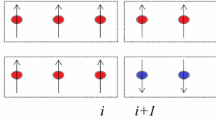Abstract
It is shown that the group of π-conjugated, nonclassical (non-Kekulé) homonuclear, alternative organic polyradicals and polymers with degenerate NBMOs can be essentially extended to a large class of heterocyclic analogues having a set of degenerate MOs. The presence of a set of degenerate MOs (DMOs) results from the molecular topology of the system. The conditions of occurrence of DMOs are determined by the generalized Coulson-Rushbrooke-Longuet-Higgins theorem. The character of spin-exchange interaction of π-electrons in the half-filled band (HFB) of a large group of model polymers, analogues of poly(meta-anilines), has been investigated. It is shown that the main component of the ferromagnetic exchange interaction is the potential (Coulomb) exchange and a smaller contribution of the indirect exchange among the HFB electrons via the delocalized π-electrons in the occupied bands. The theoretical method used, which predicts the existence of a set of DMOs, may serve as a guiding principle in the design of narrow-band, high-spin organic polymers in which cooperative magnetic phenomena can arise.
Similar content being viewed by others
References
F. Hund:Z. Phys. 51, 759 (1928).
H. C. Longuet-Higgins:Chem. Phys. 18, 265 (1950).
C. A. Coulson and G. S. Rushbrooke:Proc. Cambridge Phil. Soc. 36, 139 (1940).
C. A. Coulson and H. C. Longuet-Higgins:Proc. Roy. Soc. A191, 9;A192, 16;A193, 447 (1947).
K. Itoh:Chem. Phys. Lett. 1, 235 (1967).
E. Wasserman, R. W. Murray, W. A. Trozzolo, and G. Smolinsky:J. Am. Chem. Soc. 89, 5076 (1967).
N. Mataga:Theoret. Chim. Acta. 10, 372 (1968).
N. Tyutyulkov and I. Bangov:Compt. Rend. Acad. Bulg. Sci. 27, 1517 (1974).
A. A. Ovchinnikov:Theoret. Chim. Acta 47, 297 (1978).
D. J. Klein, C. J. Nelin, S. Alexander, and F. A. Matsen:J. Chem. Phys. 77, 3101 (1982).
N. Tyutyulkov, P. Schuster, and O. E. Polansky:Theoret. Chim. Acta 63, 291 (1983).
J. Koutecky, D. Döhnert, P. S. Wörmer, J. Paldus, and J. Cizek:J. Chem. Phys. 80, 2244 (1984).
N. Tyutyulkov, O. E. Polansky, P. Schuster, S. Karabunarliev, and C. I. Ivanov:Theoret. Chim. Acta 63, 291 (1985).
D. Maynau, Ph. Durand, J. P. Daudey, and J. P. Malrieu:Phys. Rev. A28, 3193 (1983).
H. Iwamura:Adv. Phys. Org. Chem. 26, 179 (1990).
I. Laszlo:Int. J. Quantum Chem. 50, 378 (1993).
R. Gouarne:Compt. Rend. 234, 103 (1952).
N. Tyutyulkov and O. E. Polansky:Chem. Phys. Lett. 139, 281 (1987).
S. Karabunarliev and N. Tyutyulkov:Theoret. Chim. Acta 76, 65 (1989).
K. Yoshizawa, K. Tanaka, T. Yamabe, and J. Yamauchi:J. Chem. Phys. 96, 5516 (1992).
M. Baumgarten, K. Müllen, N. Tyutyulkov, and G. Madjarova:Chem. Phys. 69, 81 (1993).
O. E. Polansky and N. Tyutyulkov:Match (Commun. Math. Chem.) 3, 149 (1977).
C. Ivanov, N. Tyutyulkov, and S. Karabunarliev:J. Magn. Mat. 92, 172 (1990).
N. Tyutyulkov and S. Karabunarliev:Chem. Phys. 112, 293 (1987).
J. Hubbard:Proc. Roy. Soc. A276, 238 (1963).
N. Mataga and K. Nishimoto:Z. Physikal. Chem. 13, 170 (1957).
K. Ohno:Theoret. Chim. Acta 2, 219 (1964).
SPARTAN, Version 3.0, Wavefunction, Inc., Irvine, CA, USA.
A. Streitwieser, Jr.:MO Theory, J. Wiley, New York (1965).
R. Pariser and G. Parr:J. Chem. Phys. 21, 466 (1953).
I. Kanev and N. Tyutyulkov:Optics and Spectroscopy (Optika i Spektroskopia, USSR)43, 222 (1977).
J. Michl, J. Koutecky, R. Becker, and Ch. E. Earhart:Theoret. Chim. Acta 19, 92 (1970).
PPP program of the Sofia quantum chemistry group.
J. E. Harriman:Theoretical Foundations of Electron Spin Resonance, Academic Press, New York (1978).
P.-O. Löwdin:Phys. Rev. 97, 1509 (1955); R. Pauncz:AMO Method, Saunders, Philadelphia (1967).
N. Tyutyulkov, P. Schuster, and O. Polansky:Theoret. Chim. Acta 63, 291 (1983).
N. Tyutyulkov and F. Dietz:Chem. Phys. 171, 293 (1993).
K. Yoshizawa, K. Tanaka, and T. Yamabe:J. Phys. Chem. 98, 1851 (1994).
Author information
Authors and Affiliations
Additional information
Part IX:Theoret. Chim. Acta 86, 353–367 (1993).
Rights and permissions
About this article
Cite this article
Müllen, K., Baumgarten, M., Tyutyulkov, N. et al. Structure and properties of nonclassical polymers X. Heteroatomic polymers with degenerate half-filled band. Mol Eng 4, 353–367 (1995). https://doi.org/10.1007/BF01019468
Received:
Revised:
Issue Date:
DOI: https://doi.org/10.1007/BF01019468




